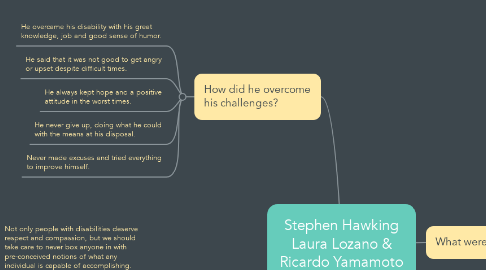Stephen Hawking Laura Lozano & Ricardo Yamamoto
by Ricardo Hitoshi Yamamoto Rojas

1. What challenges he faced?
1.1. Not only people with disabilities deserve respect and compassion, but we should take care to never box anyone in with pre-conceived notions of what any individual is capable of accomplishing.
1.2. Was diagnosed with an early-onset slow-progressing form of motor neurone disease (also known as amyotrophic lateral sclerosis (ALS) or Lou Gehrig's disease) that gradually paralysed him over the decades.
1.3. Doctors predicted that he would only have two years of live since he was detected with ALS.
1.4. His girlfriend, who became his wife, helped him to cope with the adjustment and fight depression. The disease began to break down his neurological pathways, but did not affect his mind.
1.5. He became wheel chair restricted, lost the ability to verbally communicate, and control over his limbs and body functions.
2. How did he overcome his challenges?
2.1. He overcame his disability with his great knowledge, job and good sense of humor.
2.2. He said that it was not good to get angry or upset despite difficult times.
2.3. He always kept hope and a positive attitude in the worst times.
2.4. He never give up, doing what he could with the means at his disposal.
2.5. Never made excuses and tried everything to improve himself.
3. What were his achievements?
3.1. He explainned how black holes can leak energy to the point of disappearance.
3.2. Despite his disability, he was able to express his ideas through a speech-generating device.
3.3. Hawking’s successes in physics served as an inspiration to all, and as a stark reminder of what one can achieve even in the face of severe adversity.
3.4. He inspired other people with similar diseases to move on and do all what they want, there is no mental challenge.
3.5. Another important legacy are his attempts to understand the implications of the extremely dense center of black holes.
3.6. Take his research and make it into something that can inspire both children and adults.


